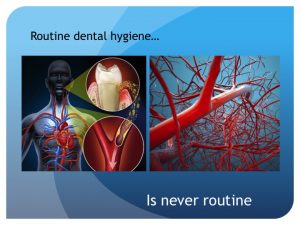
The Merrian-Webster defines paradigm shift as “an important change that happens when the usual way of thinking about or doing something is replaced by a new and different way.” There is a definite paradigm shift in dentistry and a strive to parallel our dental profession to our medical counterparts. Dr John Kempton is on this front line, helping address oral systemic health with direct patient care and as a leader inspiring others to a higher quality of care. Dr John Kempton will be our guest author for the next three weeks. Enjoy!…Richard Nagelberg, DDS.
Can locally focused adjunctive periodontal therapy, like hydrogen peroxide, lasers, and ozone, have any impact on the distant arterial micro-biomes? Emerging science regarding the existence of dormant-persistent pathogens and their release from all the human bacterial biomes now confronts treatment decisions. These dormant micro-biomes are now thought to be major contributors to ongoing chronic disease in the host and reinfection.[1][2][3] In fact very recently, micro-biomes were analyzed in carotid, coronary, and femoral arteries in a group of approximately 60 year old patients. These translocated colonies present with many high risk oral pathogens, with P.g. being the most abundant of all species.[4]
Patients walk into our offices with on-going, concurrent systemic diseases, many have genetic susceptibility to inflammatory disease or are 50 years of age or older. These factors influence the immune response, which may place an individual at a disadvantage in fighting pathogens, locally and/ or translocated. Our first action is to perform a salivary diagnostic test to determine the pathogens present in the oral cavity, then tailor a specific plan to address the source and the possible translocated micro-biomes.
The adjunctive use of specific systemic antibiotics, for high-risk patients, is currently the only therapy choice available to treat and mitigate the systemic impact of periodontitis. The standards of care need to change. In the following weeks, I will present a risk/benefit assessment to support routine dental hygiene is never routine.
[1] Potgieter M, Bester J, Kell DB, Pretorius E; The dormant blood micro-biome in chronic inflammatory diseases, FEMS Microbiol. Rev., 2015, 39, 567–591
[2] Lewis, K.;Persister cells, dormancy and infectious disease. Nature Rev. Microbiol. 2007, 5:48-56
[3] Zhang, Y; Advances in the treatment of tuberculosis. Clin. Pharmacol. Ther. 82, 595–600 (2007)
[4] Mougeot FKB, Stevens CB, Paster BJ, Brennan MT, Lockhart PB; Porphyrmonas gingivalis is the most abundant species detected in coronary and femoral arteries, JOralMicoBiology, 2017 Vol. 9: 1; 1281562 http://dx.doi.org/10.1080/20002297.2017.1281562
For more information on how to become an OralDNA Provider – scan HERE: 
- “Words of Inspiration” by Dr. John Kempton - July 7, 2023
- Words of Wisdom from Dr. John Kempton - June 24, 2022
- Establishing New Treatment Objectives for Periodontal Disease - June 22, 2018
